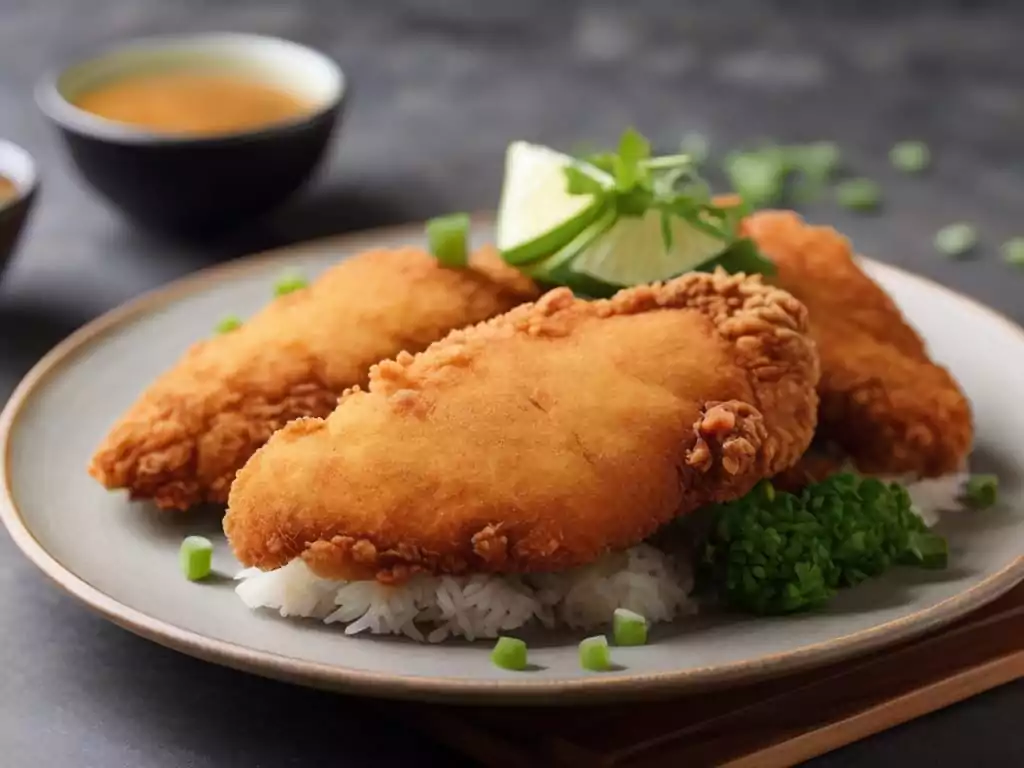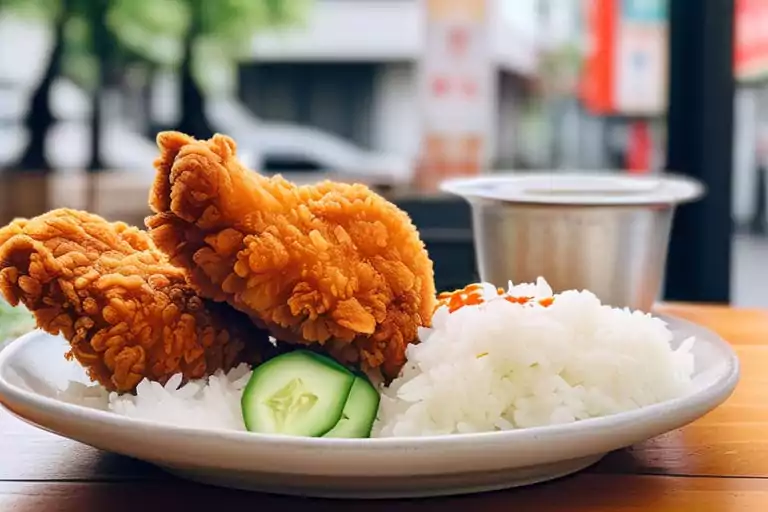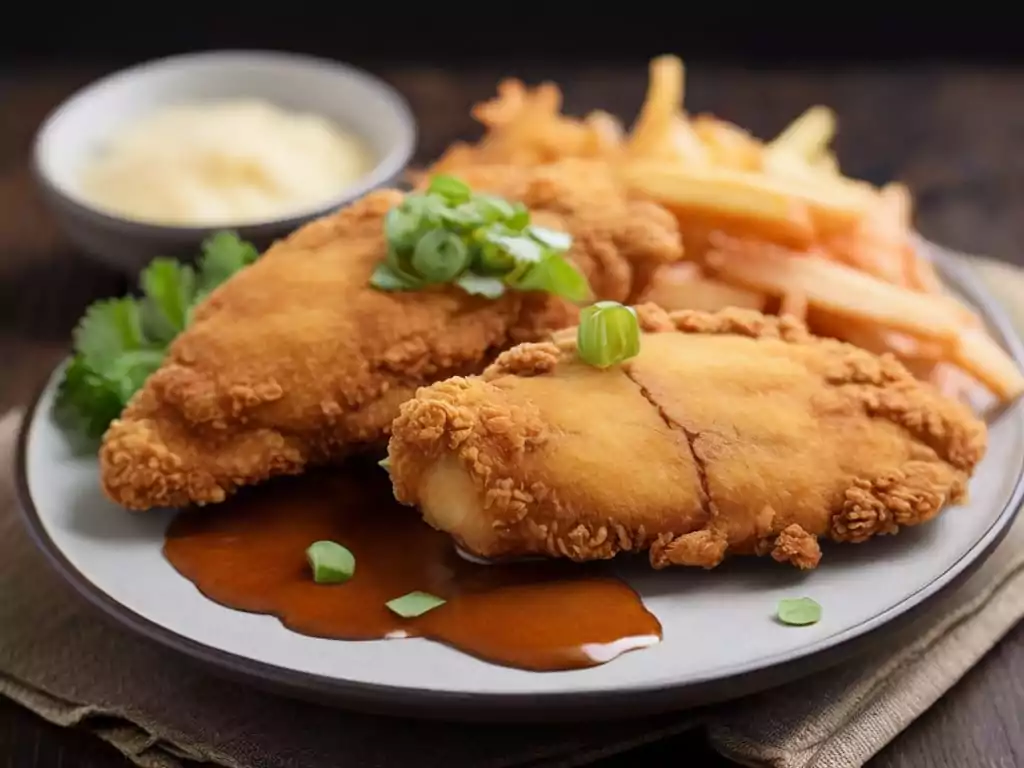Introduction: Diving Into the World of Chicken Katsu and Fried Chicken
Chicken dishes captivate food lovers around the globe. Among the myriad of ways to enjoy this versatile ingredient, chicken katsu and traditional fried chicken carve out special niches, each boasting distinctive flavors and cultural roots. This article sets out to unravel what sets these two beloved dishes apart, guiding you through their origins, cooking techniques, and the unique place each holds in the culinary world.
Tracing the Origins and Evolution
Unraveling the Stories of Two Iconic Dishes
Chicken katsu and fried chicken, at first glance, appear to diverge in the culinary landscape, yet their stories converge in a tale of culinary innovation and cultural fusion.
Chicken Katsu: A Japanese Culinary Gem
Originating in 19th century Japan, chicken katsu is a testament to culinary fusion, blending Western frying techniques with Japanese precision. This dish, featuring tender chicken enveloped in panko breadcrumbs and fried to golden perfection, is a marvel of simplicity and elegance. Served with steamed rice and tangy tonkatsu sauce, chicken katsu embodies the successful integration of Western and Eastern culinary practices.
Fried Chicken: A Comfort Food With Global Appeal
Conversely, fried chicken enjoys universal acclaim as a comfort food, with variations found across the world. Although closely tied to the American South, every culture adds its unique spin to this dish. The secret to its soul-satisfying taste lies in the marinade and coating, where spices and seasonings meet to create a flavorful, crispy delight.
A Journey Across Cultures and Time
The evolution of chicken katsu and fried chicken mirrors the dynamic flow of culinary traditions, adapting and transforming across borders. Chicken katsu has grown from its European schnitzel inspiration to become a staple of Japanese cuisine. Similarly, fried chicken has woven its way into the fabric of many cultures, each version reflecting local tastes and preferences.
In diving into the preparation methods that define chicken katsu and fried chicken, we celebrate the diversity and communal joy these dishes bring to the global table. So, let’s continue this flavorful exploration and discover the techniques that lend these dishes their unforgettable tastes and textures.
Delving into Preparation and Ingredients
Crafting the Perfect Chicken Katsu
The Art of Panko and Precision
Chicken katsu stands out for its meticulous preparation. The journey begins with selecting the right cut – typically, a boneless chicken breast, tenderized and then coated in a unique triple-layer process: flour, beaten egg, and finally, panko breadcrumbs. What sets chicken katsu apart is panko, a Japanese breadcrumb known for its airy, flaky texture, which ensures a crispy exterior unlike any other. The chicken is then fried in a shallow pool of oil, achieving a golden-brown crust while maintaining a juicy interior. This method showcases the Japanese culinary philosophy of harmony and balance, where every component must complement the others perfectly.

The Role of Tonkatsu Sauce
A vital accompaniment to chicken katsu is tonkatsu sauce, a thick, savory sauce that blends fruits and vegetables for a tangy sweetness. This sauce, often homemade in Japanese kitchens, adds depth and complexity, elevating the dish from simple fried chicken to a gastronomic experience.
The Global Art of Fried Chicken
Marinades and Coatings: A World of Flavor
Fried chicken, in its global iterations, emphasizes the importance of marinades and coatings. The American South prefers a buttermilk marinade, which tenderizes the chicken and adds tanginess, while Korean fried chicken often uses a garlic-soy mixture that imparts deep flavors. The coating varies too, from traditional flour seasoned with herbs and spices in the United States to a double-fried technique in Korea that uses cornstarch for an extra crispy finish.
Frying Techniques: From Deep to Double-Fried
The method of frying plays a crucial role in defining the dish’s texture and taste. Southern fried chicken is typically deep-fried in a cast iron skillet, ensuring a uniformly crispy exterior. In contrast, Korean fried chicken’s double-frying method crisps the skin to a delicate, crackling texture that’s light yet intensely flavorful.
Bridging Cultures Through Culinary Techniques
Both chicken katsu and fried chicken reflect the cultural attitudes towards cooking and eating. While chicken katsu embodies the Japanese pursuit of perfection and simplicity, fried chicken represents a diverse culinary landscape where flavors and techniques vary widely. Despite their differences, both dishes share a universal appeal, bringing people together through the love of a well-cooked chicken.
As we move forward, we’ll explore how these dishes are served and enjoyed across different cultures, highlighting the communal joy and individual expression found in each serving of chicken katsu and fried chicken. Stay tuned for a deeper dive into the cultural significance and serving traditions that make these dishes so beloved worldwide.
Cultural Significance and Variations
Exploring the Depths of Tradition
Both chicken katsu and fried chicken do more than just tantalize the taste buds; they carry the weight of cultural identity and history. Through these dishes, we glimpse into the societies that cherish them and the traditions that have shaped their culinary landscapes.
Chicken Katsu: More Than Just a Meal
In Japan, chicken katsu isn’t merely a dish; it’s a symbol of Western influence meshed with local culinary innovation. This dish reflects Japan’s openness to integrating outside influences while maintaining a unique identity. Chicken katsu, often found in bento boxes or as a hearty dinner, signifies comfort and nostalgia for many Japanese people. Its presence in various celebrations and everyday meals underscores its significance beyond mere sustenance.

Fried Chicken: A Global Comfort
Meanwhile, fried chicken’s appeal stretches far and wide, embodying comfort and community across cultures. In the American South, it’s a staple of family gatherings and Sunday dinners, a symbol of togetherness. Globally, variations of fried chicken capture the essence of local flavors and communal dining. From the spicy kick of Korean fried chicken to the aromatic spices of Indian versions, each tells a story of cultural pride and shared experiences.
Variations That Tell Stories
The adaptations of these dishes are as diverse as the cultures they represent. Chicken katsu finds its place in modern fusion cuisine, blending traditional Japanese flavors with global influences. Variations might include different types of sauces or even being served alongside unconventional sides, illustrating the dish’s versatility.
Fried chicken, on the other hand, showcases regional diversity through its seasoning and preparation methods. The spice levels, types of batter, and frying techniques vary, offering a taste of local history and preference. These variations not only add to the dish’s global appeal but also celebrate the unique culinary heritage of each region.
In understanding the cultural significance and variations of chicken katsu and fried chicken, we appreciate not just their flavors but the stories and traditions they bring to our tables. As we move forward, we’ll dive into the intricacies of preparation and presentation that set these dishes apart, highlighting the artistry behind the beloved flavors.
Cultural Significance and Global Influence
Bridging Cultures Through Culinary Delights
As we dive deeper into the world of chicken katsu and fried chicken, it becomes evident that these dishes do more than satiate hunger; they act as bridges between cultures, offering insights into the societies that cherish them. Let’s explore the cultural significance and the global influence these culinary gems wield.
Chicken Katsu: More Than Just a Meal
In Japan, chicken katsu is not merely a dish; it’s a symbol of Western influence harmoniously blended with local tradition. This delightful meal serves as a testament to Japan’s ability to adapt and innovate, creating something uniquely its own from foreign influences. Moreover, chicken katsu has found its way into various aspects of Japanese culture, including being a favored option in bento boxes and a popular choice for celebratory meals, emphasizing its role in bringing people together.
Fried Chicken: A Universal Language of Comfort
Similarly, fried chicken speaks a universal language of comfort and community. In the American South, it’s synonymous with family gatherings and Sunday dinners, holding a place of honor on tables laden with soul food. Beyond the United States, countries worldwide have embraced fried chicken, tailoring it to fit their culinary traditions and tastes. From the spicy, sweet flavors of Korean fried chicken to the aromatic herbs of Thai versions, fried chicken has become a global phenomenon, showcasing the universal appeal of this crispy, comforting fare.
The Global Table: Sharing and Adaptation
The global journey of chicken katsu and fried chicken illustrates the power of food to cross borders and bring people together. These dishes have traveled far from their origins, adapting to new environments and evolving with each iteration. This culinary exchange fosters understanding and appreciation among different cultures, proving that food is indeed a powerful medium for sharing stories, traditions, and flavors.
External Links to Explore
To enrich your understanding of chicken katsu and fried chicken, consider exploring the following resources:
- The History of Chicken Katsu: Dive into the fascinating history and evolution of chicken katsu in Japan and beyond.
- Fried Chicken Around the World: Discover how various cultures have embraced and personalized fried chicken, making it a global comfort food.
- The Art of Japanese Cooking: Gain insights into Japanese culinary techniques, including the meticulous preparation of chicken katsu.
As we savor the stories and flavors of chicken katsu and fried chicken, we’re reminded of the incredible diversity and creativity of global cuisines. These dishes, though simple at first glance, carry the weight of history, the joy of shared meals, and the promise of cultural discovery. Let’s continue to celebrate and explore the rich tapestry of the world’s culinary traditions, plate by plate.

Cooking Up Delights with Chicken Katsu and Fried Chicken
Perfecting Chicken Katsu at Home
To whip up chicken katsu, start with quality chicken breasts. Tenderize them, then dip in flour, egg, and panko breadcrumbs. Fry until golden. Serve sliced with tonkatsu sauce and rice or cabbage. It’s a journey from kitchen to plate that celebrates crispiness and tenderness.
The Art of Fried Chicken
For irresistible fried chicken, marinate in buttermilk and spices. Coat in seasoned flour or batter, then fry to perfection. The goal? Crispy outside, juicy inside. Keep an eye on oil temperature and frying time to avoid overcooking.
Dive Into Cooking
These dishes do more than fill your stomach. They invite you to explore and enjoy global culinary traditions. Mastering chicken katsu and fried chicken means bringing the world into your kitchen. It’s a chance to cook, share, and celebrate diverse cultures.
Further Your Culinary Skills
- Master Chicken Katsu: This guide offers steps and tips for authentic chicken katsu.
- Explore Southern Fried Chicken: Find fried chicken recipes that honor Southern traditions.
- Global Fried Chicken: Discover how fried chicken varies worldwide, showcasing its diversity.
Cooking these dishes is an adventure that connects you to cultures and traditions from around the globe. Whether making chicken katsu for a Japanese-inspired meal or serving fried chicken for a comforting feast, you’re embracing a world of culinary delights. So, get your ingredients ready, turn on the stove, and enjoy the journey to crispy, savory excellence.
Enjoying Chicken Katsu and Fried Chicken: A Guide to Presentation and Pairings
The Joy of Serving Chicken Katsu
Chefs typically slice chicken katsu to showcase its crispy crust and moist interior, pairing it with steamed rice for a satisfying texture contrast. They drizzle tonkatsu sauce over the chicken or serve it on the side, enhancing the dish with a savory sweetness. Shredded cabbage accompanies the chicken for a refreshing bite, and a lemon wedge lets diners add a splash of brightness. This presentation embodies the Japanese principle of balance, inviting diners to appreciate each component’s simplicity.
Celebrating with Fried Chicken
Fried chicken shines in its versatility, appearing in various cultural settings, always encouraging sharing and community. In the American South, it anchors a feast, surrounded by mashed potatoes, coleslaw, and biscuits, promoting a shared meal experience. Around the world, fried chicken adapts to local traditions, served with pickled radishes and beer in Korea or alongside rice in other cultures, reflecting regional tastes.
Crafting Memorable Meals
Chicken katsu and fried chicken not only delight the palate but also gather people together, creating cherished moments. These dishes, embodying comfort and community, turn ordinary meals into celebrations of connection. As we enjoy these meals, we celebrate the culinary diversity that unites us, sharing stories, traditions, and a collective joy in the universal language of food.
Tips for Enhanced Dining
- Visual Appeal: Arrange chicken katsu and fried chicken attractively to entice diners.
- Balanced Flavors: Pair these dishes with sides that offer contrasting textures and flavors for a complete sensory experience.
- Communal Settings: Serve these meals in a family-style setting to foster connection and conversation.
- Cultural Exploration: Use these dishes as an opportunity to explore and share the rich culinary traditions they represent.
By embracing these practices, we not only savor the delicious flavors of chicken katsu and fried chicken but also enrich our dining experiences, creating lasting memories around the table.
In summary, chicken katsu and fried chicken represent more than food. They are symbols of unity, creativity, and cultural pride. As we enjoy these dishes, let’s embrace the culinary journeys they offer, fostering a more connected and flavorful world.
Conclusion: The Global Tapestry of Chicken Katsu and Fried Chicken
The Essence of Culinary Exchange
Chicken katsu and fried chicken transcend mere culinary delights. They symbolize the intertwining of culture and tradition. By preparing and enjoying these dishes, we partake in a dialogue that crosses borders, celebrating the rich diversity of global cuisine. In this context, The Ultimate Chicken Katsu Guide offers a deep dive into the meticulous preparation that sets chicken katsu apart from its counterparts, providing an enriching backdrop for our exploration.
Bridging Cultures Through Cuisine
These dishes illustrate the power of food to unify cultures. Chicken katsu, with its Japanese origins, and fried chicken, a comfort food staple worldwide, demonstrate how culinary traditions can bring us together. By exploring these dishes, we engage in an exchange that highlights the universal appeal of food. For those interested in bringing this dish into their kitchen, Embracing Chicken Katsu Recipe provides practical insights into its preparation.
A Celebration of Diversity
Our journey through the world of chicken katsu and fried chicken is a tribute to the diversity and creativity inherent in global cuisine. It encourages us to explore new flavors and appreciate the art of cooking as a form of cultural expression. This exploration opens our eyes to the vast possibilities that lie in the culinary world, inviting us to embark on a journey of discovery and innovation.
The Table: A Place of Unity
Chicken katsu and fried chicken remind us of the dining table’s role as a cultural crossroads. Here, stories are shared, friendships are formed, and understanding is nurtured. These dishes serve as invitations to gather and celebrate our shared humanity, emphasizing the communal joy and individual expression found in each serving.
Embracing Culinary Adventures
Let’s continue to explore and cherish the wealth of global culinary traditions. Chicken katsu and fried chicken not only tantalize our taste buds but also encourage us to share in the joy and connection that food facilitates. They stand as emblems of cultural pride and the cohesive power of cuisine, urging us to appreciate the beauty and diversity of the world’s culinary landscapes.
Conclusion
In closing, chicken katsu and fried chicken represent much more than just meals; they are symbols of unity, creativity, and cultural pride. As we indulge in these dishes, let us embrace the culinary adventures they offer, fostering a more interconnected and flavorful world. Through this exploration, we contribute to a dialogue that enriches our understanding and appreciation of the diverse culinary traditions that shape our global community.
